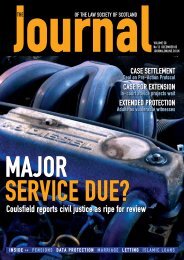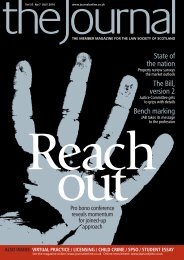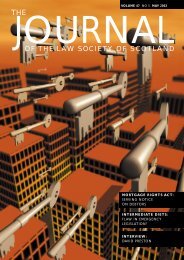Professional briefing - The Journal Online
Professional briefing - The Journal Online
Professional briefing - The Journal Online
You also want an ePaper? Increase the reach of your titles
YUMPU automatically turns print PDFs into web optimized ePapers that Google loves.
It is just a year since the<br />
Government rushed<br />
through, in a matter of<br />
days, a reduction in the<br />
VAT rate to 15%. We were told<br />
that this would stimulate the<br />
economy. Whether it did or not<br />
is one for the political<br />
commentators; but the 13 month<br />
temporary reduction is now<br />
almost at an end and we must<br />
prepare ourselves for a return to<br />
17.5% VAT on 1 January 2010.<br />
<strong>The</strong> advantage this time is that<br />
we have had time to prepare and<br />
to look for the opportunities this<br />
increase may present. <strong>The</strong><br />
disadvantage, apart from the<br />
obvious extra 2.5% we will all<br />
now pay, is that an increase<br />
presents rather more pitfalls for<br />
business than a reduction.<br />
HMRC tell us they will take a<br />
“light touch” to errors resulting<br />
from the increase. We shall see…<br />
What are the practicalities?<br />
<strong>The</strong> first and most important<br />
thing to remember is the tax<br />
point rules, and that a tax point<br />
is the date on which VAT is<br />
calculated.<br />
<strong>The</strong>re are two tax points, the<br />
basic tax point and the actual<br />
tax point.<br />
<strong>The</strong> basic tax point is created<br />
when goods are delivered or<br />
change hands and when a service<br />
is performed. However, the basic<br />
tax point is overridden by an<br />
actual tax point, which happens<br />
when money is received prior to<br />
the basic tax point or when an<br />
invoice is issued up to 14 days<br />
after the basic tax point. In<br />
simple terms, money comes first,<br />
then the supply of goods or<br />
services, and finally the invoice.<br />
<strong>The</strong>re is a concession at the time<br />
of a rate increase which allows the<br />
basic tax point to be used as the<br />
relevant date if the issue of an<br />
invoice would result in the higher<br />
rate of VAT being charged.<br />
Putting this into a practical<br />
example, if I order a new car on<br />
20 December but don’t take<br />
delivery until New Year, when I<br />
receive an invoice on the date of<br />
www.lawscotjobs.co.uk<br />
delivery, I will pay VAT at 17.5%.<br />
If, however, I receive an invoice<br />
before 31 December or pay<br />
before that date, the VAT payable<br />
will only be 15%.<br />
If (unlikely I know) I take<br />
delivery of my car on 31 December<br />
but don’t receive an invoice or pay<br />
any money until New Year, the car<br />
dealer has the option to charge<br />
17.5% based on the invoice date,<br />
or 15% because I took delivery of<br />
the car and so received the goods<br />
when the VAT rate was 15%.<br />
This presents some<br />
opportunities for cashflow<br />
boosting; but before we get to<br />
that, back to a few practicalities.<br />
Some businesses have pointed<br />
out that a change of rate at a<br />
minute past midnight on the<br />
busiest night of the year is a<br />
nonsense, and so the<br />
Government has agreed a<br />
concession for those retailers<br />
operating point of sale retail<br />
schemes who are open at<br />
midnight on 31 December. For<br />
them the VAT rate remains at<br />
15% until the end of their 31<br />
December trading session or at<br />
6am on 1 January 2010,<br />
whichever comes first.<br />
<strong>The</strong> group facing some of the<br />
trickiest of problems are those<br />
businesses who make<br />
continuous supplies of services,<br />
and so issue applications for<br />
payment rather than invoices.<br />
This broadly encompasses<br />
landlords, the construction<br />
industry and professional<br />
practices – lawyers and<br />
accountants largely. For us, the<br />
problem is that we have no basic<br />
tax point and our application for<br />
payment does not create any tax<br />
point, so that, if we issue an<br />
application at 15% but don’t get<br />
paid until 2010 when our invoice<br />
is generated by receipt of<br />
payment, we have to account for<br />
VAT at 17.5% and not the 15%<br />
we requested from our client.<br />
Where the timespan of the<br />
service to which the invoice<br />
relates is clear, such as a rent<br />
invoice, we are allowed to<br />
apportion the VAT between the<br />
Although this may amount to<br />
relatively little, with interest<br />
rates being so low an invitation<br />
to pay in advance is tempting<br />
element of time at 15% and the<br />
remainder at 17.5%, but for<br />
most true continuous services,<br />
this is difficult and time<br />
consuming to establish and,<br />
moreover, to prove.<br />
Where’s the good news?<br />
Simply, it’s all about cashflow and<br />
using this as an opportunity to<br />
give it a boost. Any private<br />
individual or business that cannot<br />
claim back all of the VAT it pays<br />
out will want to avoid the extra<br />
2.5% cost, and although this may<br />
amount to relatively little, with<br />
interest rates being so low an<br />
invitation to pay in advance is<br />
more tempting.<br />
<strong>The</strong>re is anti-forestalling<br />
legislation to prevent serious<br />
misuse of this opportunity, but<br />
this only kicks in under specific<br />
circumstances and if the<br />
customer is unable to reclaim all<br />
of the VAT charged. Where this is<br />
the case, it’s still only an issue if<br />
there is advance invoicing or<br />
payment exceeding £100,000,<br />
credit terms of more than six<br />
months, connected parties, or<br />
co-financing of the purchase.<br />
Even then, a defence of normal<br />
commercial practice could still<br />
allow the transaction at 15%.<br />
Where the anti-forestalling<br />
legislation is breached, the 15%<br />
VAT rate still applies to the pre-31<br />
December tax point but an<br />
additional 2.5% becomes<br />
immediately payable on 1<br />
January. Although I envisage the<br />
imposition of this being limited,<br />
the new penalty regime could<br />
make this an expensive move and<br />
I warn caution to anybody who<br />
thinks they might be caught by<br />
the anti-forestalling rules.<br />
Finally, let’s look on the<br />
bright side again and consider<br />
that we may be only six months<br />
or so away from another VAT<br />
rate increase. Never mind the<br />
extra cost that 20% VAT would<br />
bring: after three rate changes<br />
in about 18 months we will all<br />
be experts.<br />
Debra Dougal is a VAT partner at<br />
Haslers, chartered accountants, Essex,<br />
and a member of UK200Group Tax<br />
Panel. e: debra.dougal@haslers.com<br />
December 09 the<strong>Journal</strong> / 21










